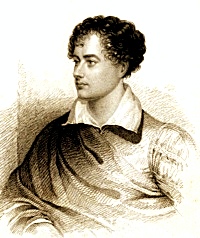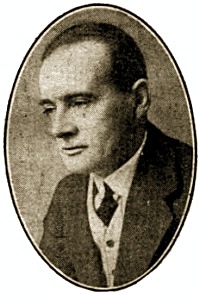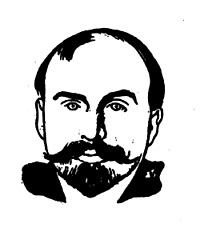Fleurs du Mal Magazine



Euthanasia
When Time, or soon or late, shall bring
The dreamless sleep that lulls the dead,
Oblivion! may thy languid wing
Wave gently o’er my dying bed!
No band of friends or heirs be there,
To weep, or wish, the coming blow:
No maiden, with dishevelled hair,
To feel, or feign, decorous woe.
But silent let me sink to earth,
With no officious mourners near:
I would not mar one hour of mirth,
Nor startle friendship with a tear.
Yet Love, if Love in such an hour
Could nobly check its useless sighs,
Might then exert its latest power
In her who lives, and him who dies.
‘Twere sweet, my Psyche! to the last
Thy features still serene to see:
Forgetful of its struggles past,
E’en Pain itself should smile on thee.
But vain the wish?for Beauty still
Will shrink, as shrinks the ebbing breath;
And women’s tears, produced at will,
Deceive in life, unman in death.
Then lonely be my latest hour,
Without regret, without a groan;
For thousands Death hath ceas’d to lower,
And pain been transient or unknown.
`Ay, but to die, and go,’ alas!
Where all have gone, and all must go!
To be the nothing that I was
Ere born to life and living woe!
Count o’er the joys thine hours have seen,
Count o’er thy days from anguish free,
And know, whatever thou hast been,
‘Tis something better not to be.
George Gordon Byron
(1788 – 1824)
Euthanasia
(Poem)
• fleursdumal.nl magazine
More in: Archive A-B, Archive A-B, Byron, Lord
The Background
“That woman’s art-jargon tires me,” said Clovis to his journalist friend. “She’s so fond of talking of certain pictures as ‘growing on one,’ as though they were a sort of fungus.”
 “That reminds me,” said the journalist, “of the story of Henri Deplis. Have I ever told it you?”
“That reminds me,” said the journalist, “of the story of Henri Deplis. Have I ever told it you?”
Clovis shook his head.
“Henri Deplis was by birth a native of the Grand Duchy of Luxemburg. On maturer reflection he became a commercial traveller. His business activities frequently took him beyond the limits of the Grand Duchy, and he was stopping in a small town of Northern Italy when news reached him from home that a legacy from a distant and deceased relative had fallen to his share.
“It was not a large legacy, even from the modest standpoint of Henri Deplis, but it impelled him towards some seemingly harmless extravagances. In particular it led him to patronize local art as represented by the tattoo-needles of Signor Andreas Pincini. Signor Pincini was, perhaps, the most brilliant master of tattoo craft that Italy had ever known, but his circumstances were decidedly impoverished, and for the sum of six hundred francs he gladly undertook to cover his client’s back, from the collar-bone down to the waistline, with a glowing representation of the Fall of Icarus. The design, when finally developed, was a slight disappointment to Monsieur Deplis, who had suspected Icarus of being a fortress taken by Wallenstein in the Thirty Years’ War, but he was more than satisfied with the execution of the work, which was acclaimed by all who had the privilege of seeing it as Pincini’s masterpiece.
“It was his greatest effort, and his last. Without even waiting to be paid, the illustrious craftsman departed this life, and was buried under an ornate tombstone, whose winged cherubs would have afforded singularly little scope for the exercise of his favourite art. There remained, however, the widow Pincini, to whom the six hundred francs were due. And thereupon arose the great crisis in the life of Henri Deplis, traveller of commerce. The legacy, under the stress of numerous little calls on its substance, had dwindled to very insignificant proportions, and when a pressing wine bill and sundry other current accounts had been paid, there remained little more than 430 francs to offer to the widow. The lady was properly indignant, not wholly, as she volubly explained, on account of the suggested writing-off of 170 francs, but also at the attempt to depreciate the value of her late husband’s acknowledged masterpiece. In a week’s time Deplis was obliged to reduce his offer to 405 francs, which circumstance fanned the widow’s indignation into a fury. She cancelled the sale of the work of art, and a few days later Deplis learned with a sense of consternation that she had presented it to the municipality of Bergamo, which had gratefully accepted it. He left the neighbourhood as unobtrusively as possible, and was genuinely relieved when his business commands took him to Rome, where he hoped his identity and that of the famous picture might be lost sight of.
“But he bore on his back the burden of the dead man’s genius. On presenting himself one day in the steaming corridor of a vapour bath, he was at once hustled back into his clothes by the proprietor, who was a North Italian, and who emphatically refused to allow the celebrated Fall of Icarus to be publicly on view without the permission of the municipality of Bergamo. Public interest and official vigilance increased as the matter became more widely known, and Deplis was unable to take a simple dip in the sea or river on the hottest afternoon unless clothed up to the collarbone in a substantial bathing garment. Later on the authorities of Bergamo, conceived the idea that salt water might be injurious to the masterpiece, and a perpetual injunction was obtained which debarred the muchly harassed commercial traveller from sea bathing under any circumstances. Altogether, he was fervently thankful when his firm of employers found him a new range of activities in the neighbourhood of Bordeaux. His thankfulness, however, ceased abruptly at the Franco–Italian frontier. An imposing array of official force barred his departure, and he was sternly reminded of the stringent law which forbids the exportation of Italian works of art.
“A diplomatic parley ensued between the Luxemburgian and Italian Governments, and at one time the European situation became overcast with the possibilities of trouble. But the Italian Government stood firm; it declined to concern itself in the least with the fortunes or even the existence of Henri Deplis, commercial traveller, but was immovable in its decision that the Fall of Icarus (by the late Pincini, Andreas) at present the property of the municipality of Bergamo, should not leave the country.
“The excitement died down in time, but the unfortunate Deplis, who was of a constitutionally retiring disposition, found himself a few months later, once more the storm-centre of a furious controversy. A certain German art expert, who had obtained from the municipality of Bergamo permission to inspect the famous masterpiece, declared it to be a spurious Pincini, probably the work of some pupil whom he had employed in his declining years. The evidence of Deplis on the subject was obviously worthless, as he had been under the influence of the customary narcotics during the long process of pricking in the design. The editor of an Italian art journal refuted the contentions of the German expert and undertook to prove that his private life did not conform to any modern standard of decency. The whole of Italy and Germany were drawn into the dispute, and the rest of Europe was soon involved in the quarrel. There were stormy scenes in the Spanish Parliament, and the University of Copenhagen bestowed a gold medal on the German expert (afterwards sending a commission to examine his proofs on the spot), while two Polish schoolboys in Paris committed suicide to show what THEY thought of the matter.
“Meanwhile, the unhappy human background fared no better than before, and it was not surprising that he drifted into the ranks of Italian anarchists. Four times at least he was escorted to the frontier as a dangerous and undesirable foreigner, but he was always brought back as the Fall of Icarus (attributed to Pincini, Andreas, early Twentieth Century). And then one day, at an anarchist congress at Genoa, a fellow-worker, in the heat of debate, broke a phial full of corrosive liquid over his back. The red shirt that he was wearing mitigated the effects, but the Icarus was ruined beyond recognition. His assailant was severely reprimanded for assaulting a fellow-anarchist and received seven years’ imprisonment for defacing a national art treasure. As soon as he was able to leave the hospital Henri Deplis was put across the frontier as an undesirable alien.
“In the quieter streets of Paris, especially in the neighbourhood of the Ministry of Fine Arts, you may sometimes meet a depressed, anxious-looking man, who, if you pass him the time of day, will answer you with a slight Luxemburgian accent. He nurses the illusion that he is one of the lost arms of the Venus de Milo, and hopes that the French Government may be persuaded to buy him. On all other subjects I believe he is tolerably sane.”
The Background
From ‘The Chronicles of Clovis’
by Saki (H. H. Munro)
(1870 – 1916)
• fleursdumal.nl magazine
More in: Archive S-T, Saki, Saki, The Art of Reading

Kind met het bleek gelaat
Kind met het bleek gelaat, dat van uw wijde blikken
geen liefde in mat gebaar noch in lede ogen ziet,
maar in uw zedig kleed uw knieën weet te schikken
zó, dat me te elken male een laaie drift doorschiet:
gij zult het nimmer aan mijn vrome woorden weten
hoe mijn begeren om uw kleren dolen dorst;
maar ìk draag in me-zelf de wonde, zelf gereten,
waarvan de koortse rilt en davert door mijn borst.
Want ‘k heb de straffe zélf in ‘t lillend vlees geslagen;
ik heb een spijt’ge spot gehamerd in mijn brein…
– Gij echter, ga voorbij, arm kind, en zónder vragen:
ik haat u om dees geert’, die ‘k minne om deze pijn…
Karel van de Woestijne
(1878 – 1929)
Kind met het bleek gelaat
Portret: Karel van de Woestijne, Ramah – Journal Het Roode Zeil, 15 April 1920
• fleursdumal.nl magazine
More in: Archive W-X, Archive W-X, Woestijne, Karel van de

Triolet En Scie Majeure
Ce jeune lapin gras et digne
A pour petit nom Daniel.
Il est rouge comme une guigne,
Ce jeune lapin gras et digne.
Vous n’avez qu’à lui faire signe:
Il file doux comme du miel.
Ce jeune lapin gras et digne
A pour petit nom Daniel.
Ce jeune lapin gras et digne
A pour petit nom Daniel.
Si vous avez une consigne,
Ce jeune lapin gras et digne
De sa main blanche comme un cygne
Vous fera monter jusqu’au ciel.
Ce jeune lapin gras et digne
A pour petit nom Daniel.
Ce jeune lapin gras et digne
A pour petit nom Daniel.
Le teint fleuri comme la vigne,
Ce jeune lapin gras et digne,
Avec une oeillade maligne,
Flûte en parlant, comme Ariel.
Ce jeune lapin gras et digne
A pour petit nom Daniel.
Ce jeune lapin gras et digne
A pour petit nom Daniel.
Depuis huit jours il a la guigne,
Ce jeune lapin gras et digne:
Je ne puis écrire une ligne
Sans qu’il y soit trempé de fiel.
Ce jeune lapin gras et digne
A pour petit nom Daniel.
Marcel Schwob
(1867-1905)
Triolet En Scie Majeure
Juin 1888
Portrait: Félix Vallotton
• fleursdumal.nl magazine
More in: Archive S-T, Archive S-T, Félix Vallotton, Marcel Schwob
Thank you for reading Fleurs du Mal - magazine for art & literature